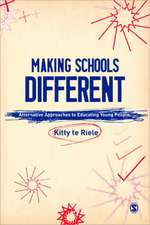Understanding Contemporary Education: Key themes and issues
Autor Tom O'Donoghueen Limba Engleză Paperback – 12 iul 2016
In each chapter, a concept is carefully considered, with major features, controversies, and strengths and weaknesses highlighted. Key follow-up questions challenge the reader to reflect on specific issues, and encourage involvement, not just in their own teaching, but in the planning and determination of the total programme of their school, and where possible, that of the nation.
The book is divided into seven main parts:
- The Social Context of Education
- Education Policy
- Curriculum
- Teaching and Learning
- Leadership in Education
- Teacher Preparation
- International Developments in Education.
| Toate formatele și edițiile | Preț | Express |
|---|---|---|
| Paperback (1) | 234.90 lei 6-8 săpt. | |
| Taylor & Francis – 12 iul 2016 | 234.90 lei 6-8 săpt. | |
| Hardback (1) | 739.24 lei 6-8 săpt. | |
| Taylor & Francis – 4 iul 2016 | 739.24 lei 6-8 săpt. |
Preț: 234.90 lei
Preț vechi: 281.27 lei
-16% Nou
Puncte Express: 352
Preț estimativ în valută:
44.95€ • 47.06$ • 37.19£
44.95€ • 47.06$ • 37.19£
Carte tipărită la comandă
Livrare economică 05-19 aprilie
Preluare comenzi: 021 569.72.76
Specificații
ISBN-13: 9781138678262
ISBN-10: 1138678260
Pagini: 260
Dimensiuni: 174 x 246 x 17 mm
Greutate: 0.45 kg
Ediția:1
Editura: Taylor & Francis
Colecția Routledge
Locul publicării:Oxford, United Kingdom
ISBN-10: 1138678260
Pagini: 260
Dimensiuni: 174 x 246 x 17 mm
Greutate: 0.45 kg
Ediția:1
Editura: Taylor & Francis
Colecția Routledge
Locul publicării:Oxford, United Kingdom
Public țintă
Professional and UndergraduateCuprins
Chapter 1: The Scope of the Book
PART ONE: THE SOCIAL CONTEXT OF EDUCATION
Chapter 2: The Functions of Education;
Chapter 3: Education versus Training;
Chapter 4: Stages of Education Development;
Chapter 5: Education and National Development;
Chapter 6: Globalization and Education.
PART TWO: EDUCATION POLICY
Chapter 7: Key Foci of Policy Analysis;
Chapter 8: Education Policy Orientations;
Chapter 9: Models for Analysing Education Policy;
Chapter 10: Policy Borrowing;
Chapter 11: Policy Changes in Higher Education.
PART THREE: CURRICULUM
Chapter 12: Orientations to Curriculum;
Chapter 13: Approaches to Curriculum Planning;
Chapter 14: Outcomes-based Education;
Chapter 15: Alternatives to the Objectives Model for Curriculum Planning;
Chapter 16: The Curriculum Ideas of Kieran Egan.
PART FOUR: TEACHING AND LEARNING
Chapter 17: Learning and the Conditions that Enhance Learning;
Chapter 18:Questioning Some Taken-for Granted Assumptions about Teaching and Learning;
Chapter 19: Approaches to Teaching;
Chapter 20: Learning Through Making and Doing;
Chapter 21: Direct Instruction.
PART FIVE: LEADERSHIP IN EDUCATION
Chapter 21: Different Types of Leadership;
Chapter 23: Leadership for Learning;
Chapter 24: Leadership in Assessment for Learning
Chapter 25: Leadership for Change
Chapter 26: Some Challenging Positions for Leaders to Consider.
PART SIX: TEACHER PREPARATION
Chapter 27: The Evolution of Teacher Preparation;
Chapter 28: A Model to Inform Planning for Teacher Preparation;
Chapter 29: Globalisation, Internationalisation and Teacher Preparation;
Chapter 30: Teacher Induction;
Chapter 31: Alternative Models of Teacher Preparation.
PART SEVEN: International Developments in Education
Chapter 32: Standardised Testing;
Chapter 33: National Curriculum;
Chapter 34: Education in Countries in Transition;
Chapter 35: Shadow Education;
Chapter 36: The Challenge of ICT in the Classroom.
PART ONE: THE SOCIAL CONTEXT OF EDUCATION
Chapter 2: The Functions of Education;
Chapter 3: Education versus Training;
Chapter 4: Stages of Education Development;
Chapter 5: Education and National Development;
Chapter 6: Globalization and Education.
PART TWO: EDUCATION POLICY
Chapter 7: Key Foci of Policy Analysis;
Chapter 8: Education Policy Orientations;
Chapter 9: Models for Analysing Education Policy;
Chapter 10: Policy Borrowing;
Chapter 11: Policy Changes in Higher Education.
PART THREE: CURRICULUM
Chapter 12: Orientations to Curriculum;
Chapter 13: Approaches to Curriculum Planning;
Chapter 14: Outcomes-based Education;
Chapter 15: Alternatives to the Objectives Model for Curriculum Planning;
Chapter 16: The Curriculum Ideas of Kieran Egan.
PART FOUR: TEACHING AND LEARNING
Chapter 17: Learning and the Conditions that Enhance Learning;
Chapter 18:Questioning Some Taken-for Granted Assumptions about Teaching and Learning;
Chapter 19: Approaches to Teaching;
Chapter 20: Learning Through Making and Doing;
Chapter 21: Direct Instruction.
PART FIVE: LEADERSHIP IN EDUCATION
Chapter 21: Different Types of Leadership;
Chapter 23: Leadership for Learning;
Chapter 24: Leadership in Assessment for Learning
Chapter 25: Leadership for Change
Chapter 26: Some Challenging Positions for Leaders to Consider.
PART SIX: TEACHER PREPARATION
Chapter 27: The Evolution of Teacher Preparation;
Chapter 28: A Model to Inform Planning for Teacher Preparation;
Chapter 29: Globalisation, Internationalisation and Teacher Preparation;
Chapter 30: Teacher Induction;
Chapter 31: Alternative Models of Teacher Preparation.
PART SEVEN: International Developments in Education
Chapter 32: Standardised Testing;
Chapter 33: National Curriculum;
Chapter 34: Education in Countries in Transition;
Chapter 35: Shadow Education;
Chapter 36: The Challenge of ICT in the Classroom.
Notă biografică
Tom O'Donoghue is Professor of Education in the Graduate School of Education, The University of Western Australia, Australia.
Descriere
This must-read book offers an exploration of key concepts that will allow trainee and practising teachers to engage in reflection, not only of their work at classroom level, but on education more broadly. Organised into five areas of concern: education policy, curriculum, teaching and learning, leadership in education, and teacher preparation, each concept is considered, with major features, controversies, and strengths and weaknesses highlighted. Follow-up questions challenge the reader to reflect on specific issues, and encourage involvement, not just in their own teaching, but in the planning and determination of the total programme of their school, and where possible, that of the nation.









